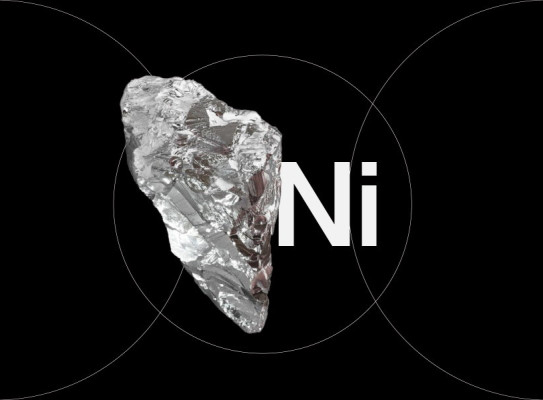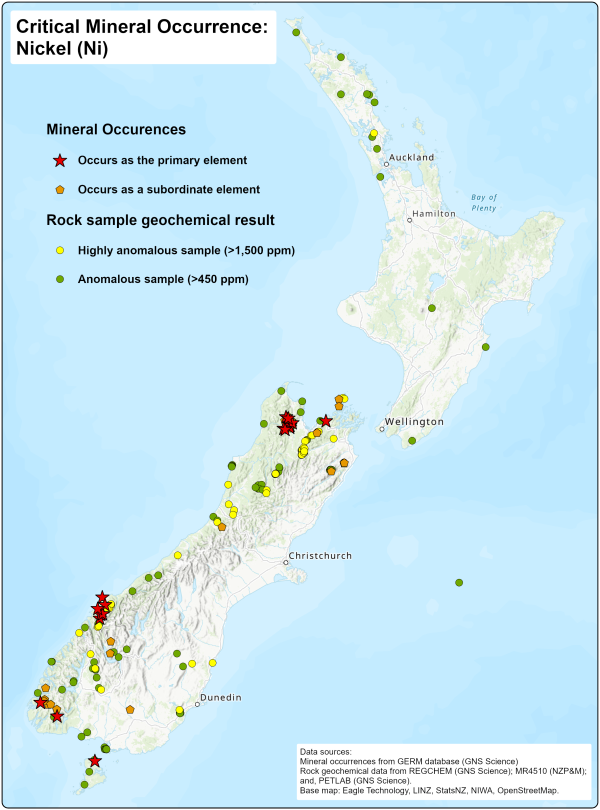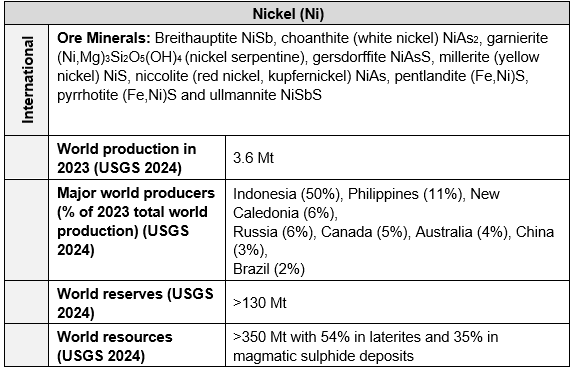Nickel

Nickel (Ni) is a versatile and corrosion-resistant metal essential for stainless steel, high-performance alloys, batteries, and clean energy technologies. It plays a crucial role in modern industry, sustainable energy solutions, and advanced manufacturing
Nickel in New Zealand
Nickel is associated with mafic-ultramafic rocks in the South Island. The nickel and associated metals precipitated out during cooling and crystallisation of mafic-ultramafic magmas. Nickel occurs as pentlandite, along with accessory minerals pyrrhotite, chalcopyrite and magnetite. The relatively high density of the sulphur liquids and associated sulphide minerals results in these settling at the base of the magma chamber, potentially at ore-grade concentrations. In New Zealand, these types of deposits are classified as Dunitic Ni-Cu and Gabbroid-associated Ni-Cu. Weathering of these primary deposits may develop Lateritic Ni.

Key Uses of Nickel
Stainless Steel and Alloys - Over 65% of nickel is used in stainless steel, enhancing strength, durability, and corrosion resistance for construction, medical tools, and industrial equipment.
Batteries and Electric Vehicles (EVs) - Nickel is a key component in lithium-ion batteries, increasing energy density and efficiency in EVs, grid storage, and portable electronics.
Superalloys and Aerospace - Used in high-temperature alloys for jet engines, turbines, and space technology.
Chemical and Catalytic Applications - Nickel-based catalysts are vital in hydrogen production, petrochemicals, and synthetic materials.
Coinage and Coatings - Nickel is used in coins, electroplating, and corrosion-resistant coatings.
Geological Sources of Nickel
Nickel is primarily extracted from two main geological deposit types:
- Laterite Deposits – Formed by weathering of ultramafic rocks in tropical climates, yielding nickel-rich oxide ores (e.g., Indonesia, Philippines).
- Magmatic Sulphide Deposits – Found in mafic-ultramafic intrusions, often associated with copper and platinum-group elements (e.g., Russia, Canada, Australia).
- Other sources include seafloor manganese nodules, which contain nickel as a secondary resource.

Exploration and Mining
Indonesia, the Philippines, Russia, Canada, and Australia are the world's largest nickel producers. Sulphide deposits are preferred for battery-grade nickel, while laterites dominate global production.
Future Demand and Applications
Nickel demand is rising due to its role in electric vehicles, renewable energy storage, and hydrogen fuel technologies. The transition to low-carbon energy makes nickel a critical mineral for global sustainability and technological advancement.
For geologists and explorers, nickel remains a key exploration target, offering opportunities in high-grade sulphide systems, laterite-rich regions, and emerging deep-sea resources.
Additional Reading
Christie AB, Barker RG. 2016. Regional mineral resource assessments to promote recognition of mineral resource potential. In: Christie AB, editor. Mineral deposits of New Zealand: exploration and research. Carlton (AU): Australasian Institute of Mining and Metallurgy. p. 45–52. (Australasian Institute of Mining and Metallurgy monograph series; 31).
Christie AB, Turnbull RE. 2016. Exploration of nickel-copper mineralisation in mafic and ultramafic rocks of the Riwaka Complex, West Nelson, South Island. In: Christie AB, editor. Mineral deposits of New Zealand: exploration and research. Carlton (AU): Australasian Institute of Mining and Metallurgy. p. 453–462. (Australasian Institute of Mining and Metallurgy monograph series; 31).
Turnbull RE, Size WB, Tulloch AJ, Christie AB. 2017. The ultramafic–intermediate Riwaka Complex, New Zealand: summary of the petrology, geochemistry and related Ni–Cu–PGE mineralisation. New Zealand Journal of Geology and Geophysics. 60(3):270–295. https://doi.org/10.1080/00288306.2017.1316747(external link)
Durance PMJ, Hill MP, Turnbull RE, Morgenstern R, Rattenbury MS. 2018. Nickel and cobalt mineral potential in New Zealand. Lower Hutt (NZ): GNS Science. 223 p. Consultancy Report 2018/64. Prepared for New Zealand Petroleum and Minerals.